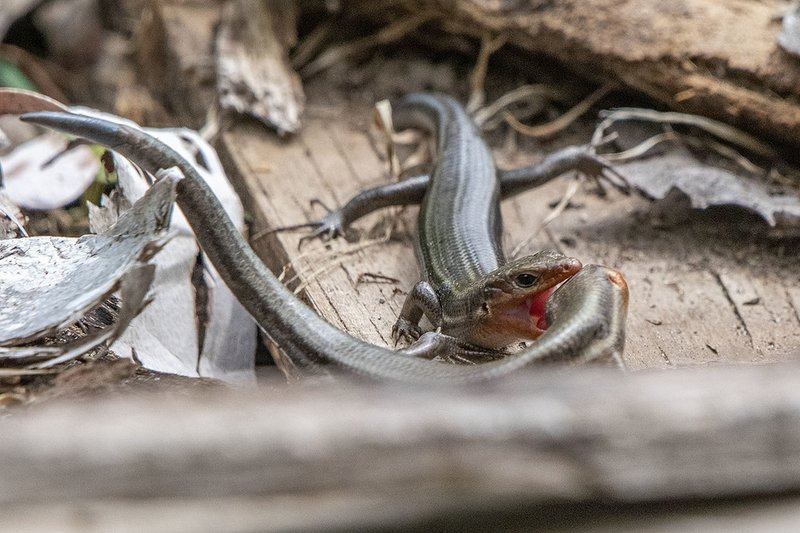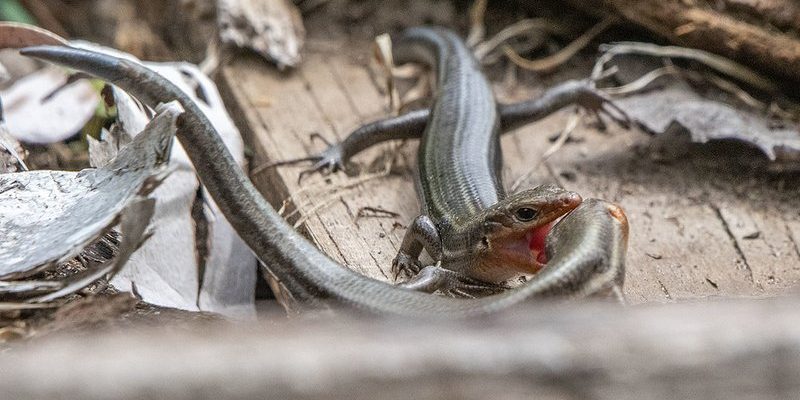
The Five-Lined Skink is one of nature’s fascinating little reptiles. With their sleek, shiny bodies and striking color patterns, they are often the stars of the show in gardens and wooded areas. Imagine a small creature that can dart away in a flash, its bright lines shimmering in the sunlight. It’s like a live-action cartoon character! These lizards may be small, but they pack a lot of personality and interesting traits into their tiny frames.
If you’ve ever spotted one skittering across a rock or sunbathing on a warm day, you might have wondered what makes them tick. Where do they live? What do they eat? Let’s dive into the world of the Five-Lined Skink and discover what makes them special in the animal kingdom.
Physical Characteristics
The Five-Lined Skink is easily recognizable by its characteristic lines. Typically, it boasts five distinct stripes running down its back. These stripes can be a beautiful mix of colors, including blue, green, and brown. The contrast between the bright lines and their dark body helps them camouflage in their woodland habitats. You might say it’s nature’s own design to keep them safe from predators.
On average, adult Five-Lined Skinks grow to about 7 to 8 inches long, making them one of the smaller lizard species. Their smooth scales give them a shiny appearance, almost like they’ve been polished! When they feel threatened, their first line of defense is to make a quick escape, but they can also lose their tails. If you ever spot one with a shorter tail, that’s probably a survival trick they’ve learned over time.
Another interesting aspect of their appearance is how their coloration can change based on age and sex. Juveniles often have bright blue tails, which fade as they grow older. This vibrant feature not only adds to their charm but also highlights how dynamic the world of reptiles can be.
Habitat and Range
The habitat of the Five-Lined Skink is as varied as its colorful appearance. You can typically find them in grassy areas, woodlands, or near rocks and logs. They prefer environments that offer plenty of hiding spots and warmth, like sunny patches where they can bask during the day. It’s not uncommon to see them scurrying about in gardens, making them a delightful visitor for nature enthusiasts.
Geographically, these skinks are quite widespread. In the United States, they are mainly located in the eastern and southern regions. From southern New England all the way to Florida, their range covers a broad area. This adaptability to different environments is partly what makes them successful in the wild.
Interestingly, the conditions they thrive in can vary from moist woodlands to dry savannas. This flexibility in habitat choice showcases just how resilient these little creatures can be. Next time you’re out in nature, keep your eyes peeled—you might just spot a Five-Lined Skink enjoying its home!
Diet and Feeding Habits
When it comes to dining, the Five-Lined Skink isn’t picky. Their diet primarily consists of insects and other small invertebrates. You might find them snacking on ants, beetles, or even small spiders! Watching them hunt can be a real treat. They rely on their quick reflexes and keen eyesight to catch their next meal.
It’s important to note that these skinks play an essential role in the ecosystem. By feeding on insects, they help control pest populations, making them valuable allies in gardens and natural habitats. Imagine hosting a tiny pest-control squad right in your backyard!
The Five-Lined Skink typically hunts during the day, using its agility to dart in and out of cover as it searches for food. They have a remarkable ability to spot movement, which helps them catch their meals quickly. And if you think that’s impressive, wait until you see how they eat! They can consume prey that’s almost half their size, thanks to their strong jaws.
Behavior and Social Structure
Five-Lined Skinks are primarily solitary creatures, but they can sometimes be found basking together in suitable habitats. They enjoy the warmth of the sun, and you might catch a few lounging on a rock or log during the afternoon. It’s a communal act, albeit brief, and showcases their need for warmth, especially after a cool night.
When it comes to communication, these lizards are not as vocal as some other species. Instead, they rely on body language and visual signals. If you’ve ever seen one puff up its body or quickly dart away, it’s expressing either confidence or a desire to escape. This interaction is vital for their survival, as it helps them avoid threats and blend into their surroundings.
Interestingly, male Five-Lined Skinks can be quite territorial during breeding season. They may engage in displays of strength or chase away rivals. This behavior is essential for establishing dominance and ensuring they have access to the best basking spots and the chance to attract a mate. Such dynamics highlight the complexities of their social interactions, even among such small creatures.
Reproduction and Lifespan
The reproduction of the Five-Lined Skink is a fascinating aspect of their life cycle. Mating usually takes place in the spring, and females can lay anywhere from 4 to 10 eggs in a nest made of soil, leaf litter, or under rocks. The eggs are often hidden to protect them from potential predators. Once laid, the female will typically abandon the eggs, as she doesn’t provide any parental care. It’s a risky venture, but nature has its ways of ensuring at least some eggs survive.
Incubation lasts about two months, and the hatchlings usually emerge in late summer. They are tiny replicas of their adults, ready to fend for themselves right from the start. This independence is crucial for their survival, as they must find food and avoid predators immediately. The young skinks are often more vulnerable during this stage, so their ability to hide and escape quickly is vital.
In terms of lifespan, Five-Lined Skinks can live up to 6 years in the wild, but some may reach up to 10 years in captivity. The factors contributing to their lifespan include environmental conditions, availability of food, and the presence of predators. It’s a tough world out there, but these skinks manage to navigate it with impressive efficiency.
Conservation Status
Currently, the Five-Lined Skink is not considered endangered, but various threats do exist that can impact their populations. Habitat destruction, particularly urban development and agriculture, poses a significant risk. As their natural habitats shrink, their survival becomes increasingly challenging. It’s crucial to protect these environments to ensure the prosperity of not just skinks but countless other species as well.
Another concern is the use of pesticides in gardens and agricultural areas. While these chemicals are intended to manage pests, they can also harm beneficial insects and reptiles like the Five-Lined Skink. There is a growing movement towards more sustainable practices that reduce chemical use, creating a healthier environment for wildlife.
Supporting local conservation efforts and being mindful of our gardening practices can make a difference. Every little action counts! By planting native species and avoiding harmful chemicals, we can help maintain the habitats that these charming lizards call home.
Interesting Facts
| Common Name: | Five-Lined Skink |
| Scientific Name: | Plestiodon fasciatus |
| Size: | 7-8 inches |
| Diet: | Insects and small invertebrates |
| Lifespan: | 5-10 years |
| Habitat: | Woodlands and grassy areas |
| Range: | Eastern and southern United States |
FAQ
What do Five-Lined Skinks eat?
Five-Lined Skinks primarily feed on insects and other small invertebrates. Their diet typically includes ants, beetles, and even small spiders. This diet helps control pest populations, making them beneficial for gardens and natural ecosystems.
Are Five-Lined Skinks friendly towards humans?
While Five-Lined Skinks are not aggressive, they tend to be shy and will quickly scurry away when approached. They don’t pose any threat to humans; instead, they prefer to hide when feeling threatened. Observing them from a distance is the best way to enjoy their company!
How can I attract Five-Lined Skinks to my garden?
To attract Five-Lined Skinks, create a welcoming environment with plenty of rocks, logs, and sunny areas for basking. Additionally, minimizing pesticide use will help maintain a healthy ecosystem, drawing in insects that these skinks love to feast on.
Can Five-Lined Skinks change color?
Five-Lined Skinks don’t change colors like chameleons, but their coloration can vary with age and sex. Juveniles can have bright blue tails that fade as they mature, making them look quite different over time.
What predators threaten Five-Lined Skinks?
Five-Lined Skinks face threats from various predators, including birds, snakes, and larger mammals. Their ability to dart away and blend into their surroundings helps them avoid many dangers, but they are still at risk from the natural world.
Do Five-Lined Skinks hibernate?
Yes, Five-Lined Skinks do enter a state of brumation (a form of hibernation) during colder months. They seek shelter under rocks or in burrows to stay warm and conserve energy until the temperatures rise again.
Are Five-Lined Skinks social animals?
Generally, Five-Lined Skinks are solitary creatures. While they may bask in groups at times, especially during warmer days, they do not form complex social structures. They prefer to keep to themselves, except during mating season.
How can I identify a Five-Lined Skink?
You can identify a Five-Lined Skink by looking for its characteristic five stripes running along its back. They are relatively small, usually around 7 to 8 inches long, with a smooth and shiny appearance. Their striking color patterns make them stand out in their natural habitat.
What should I do if I find a Five-Lined Skink in my yard?
If you find a Five-Lined Skink in your yard, it’s best to leave it be. They are beneficial creatures that help control insect populations. If you need to relocate it, do so gently and remember that creating a suitable habitat for them is key to encouraging their presence.
How long do Five-Lined Skinks live?
In the wild, Five-Lined Skinks can live up to 6 years, but some may reach 10 years in captivity. Their lifespan can vary based on environmental factors, food availability, and predation risks.

